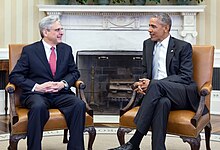| Merrick Garland Supreme Court nomination | |
|---|---|
 Garland with President Obama on March 17, 2016 shortly after his nomination was announced. | |
| Nominee | Merrick Garland |
| Nominated by | Barack Obama (president of the United States) |
| Succeeding | Antonin Scalia (associate justice) |
| Date nominated | March 16, 2016 |
| Date lapsed | January 3, 2017 |
| Outcome | Nomination lapsed without action |
| ||
|---|---|---|
|
Personal
Illinois State Senator and U.S. Senator from Illinois 44th President of the United States
Tenure
 |
||
On March 16, 2016, President Barack Obama nominated Merrick Garland for Associate Justice of the Supreme Court of the United States to succeed Antonin Scalia, who had died one month earlier. At the time of his nomination, Garland was the chief judge of the United States Court of Appeals for the District of Columbia Circuit.
This vacancy arose during Obama's final year as president. Hours after Scalia's death was announced, Senate Majority Leader Mitch McConnell said he would consider any appointment by the sitting president to be null and void. He said the next Supreme Court justice should be chosen by the next president—to be elected later that year.[1][2][3] Senate Democrats criticized the move as being unprecedented. They argued that there was sufficient time to vote on a nominee before the election.[4]
Scalia's death brought about an unusual, but not unprecedented, situation in which a Democratic president had the opportunity to nominate a Supreme Court justice with the Republican controlled United States Senate. Before 2016, such a situation had last arisen in 1895, when a Republican-led Senate confirmed Democrat Grover Cleveland's nomination of Rufus Wheeler Peckham to the Court in a voice vote;[5][6] conversely, in 1988 a Democratic-led Senate had confirmed Republican Ronald Reagan's nomination of Anthony Kennedy and in 1991, a Senate held 57–43 by Democrats nevertheless confirmed Justice Clarence Thomas.[7]: 75–83 Political commentators at the time widely recognized Scalia as one of the most conservative members of the Court, and noted that—while many considered Merrick Garland a centrist, and he had been called "essentially the model, neutral judge"[8]—a replacement less conservative than Scalia could have shifted the Court's ideological balance for many years into the future. The confirmation of Garland would have given Democratic appointees a majority on the Supreme Court for the first time since the 1970 confirmation of Harry Blackmun.[9]
The 11 members of the Senate Judiciary Committee's Republican majority refused to conduct the hearings necessary to advance the vote to the Senate at large, and Garland's nomination expired on January 3, 2017, with the end of the 114th Congress, 293 days after it had been submitted to the Senate.[10] This marked the first time since the Civil War that a nominee whose nomination had not been withdrawn had failed to receive consideration for an open seat on the Court.[11] Obama's successor, Donald Trump (a Republican), nominated Judge Neil Gorsuch to fill the vacancy on January 31, 2017, soon after taking office.[10]
- ^ "What Happened With Merrick Garland In 2016 And Why It Matters Now". npr.org. June 29, 2018. Retrieved September 21, 2020.
- ^ "McConnell On Supreme Court Nomination". Official website of the Republican Leader of the U.S. Senate (Sen. Mitch McConnell. March 16, 2016. Retrieved September 21, 2020.
- ^ "What every Republican senator has said about filling a Supreme Court vacancy in an election year". PBS News Hour. September 19, 2020. Retrieved September 21, 2020.
- ^ "Remarks by the President on the Passing of the U.S. Supreme Court Justice Antonin Scalia". whitehouse.gov. February 13, 2016. Retrieved February 14, 2016 – via National Archives.
- ^ Savage, David G. (November 8, 2014). "Obama unlikely to alter Supreme Court ideology with Republican Senate". Los Angeles Times. Retrieved March 12, 2016.
- ^ Bomboy, Scott (August 13, 2014). "The facts about Supreme Court nominations and Senate control". Constitution Daily. Philadelphia, Pennsylvania: National Constitution Center. Retrieved June 15, 2019.
- ^ Cite error: The named reference
KarMazzonewas invoked but never defined (see the help page). - ^ "The Potential Nomination of Merrick Garland". SCOTUSblog. April 26, 2010. Retrieved September 22, 2020.
- ^ Chemerinsky, Erwin (April 6, 2016). "What If the Supreme Court Were Liberal?". The Atlantic. Retrieved December 16, 2016.
- ^ a b Cite error: The named reference
jbravin1was invoked but never defined (see the help page). - ^ Trickey, Erick. "The History of "Stolen" Supreme Court Seats". Smithsonian Magazine. Retrieved September 22, 2020.

